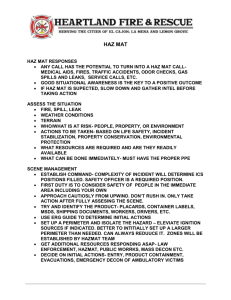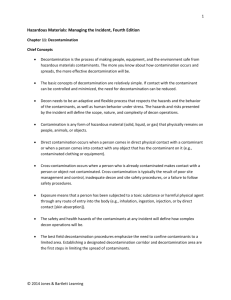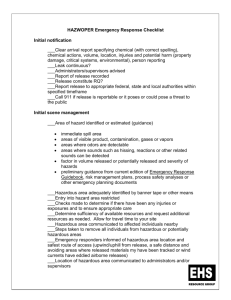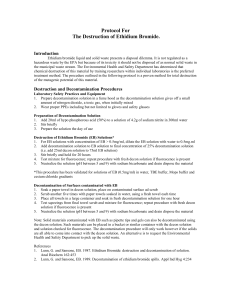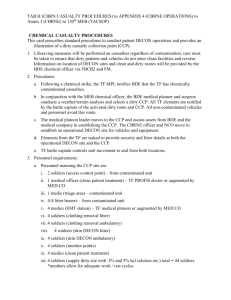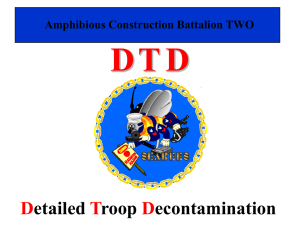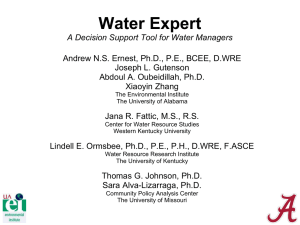MCI Decontamination Checksheet
advertisement
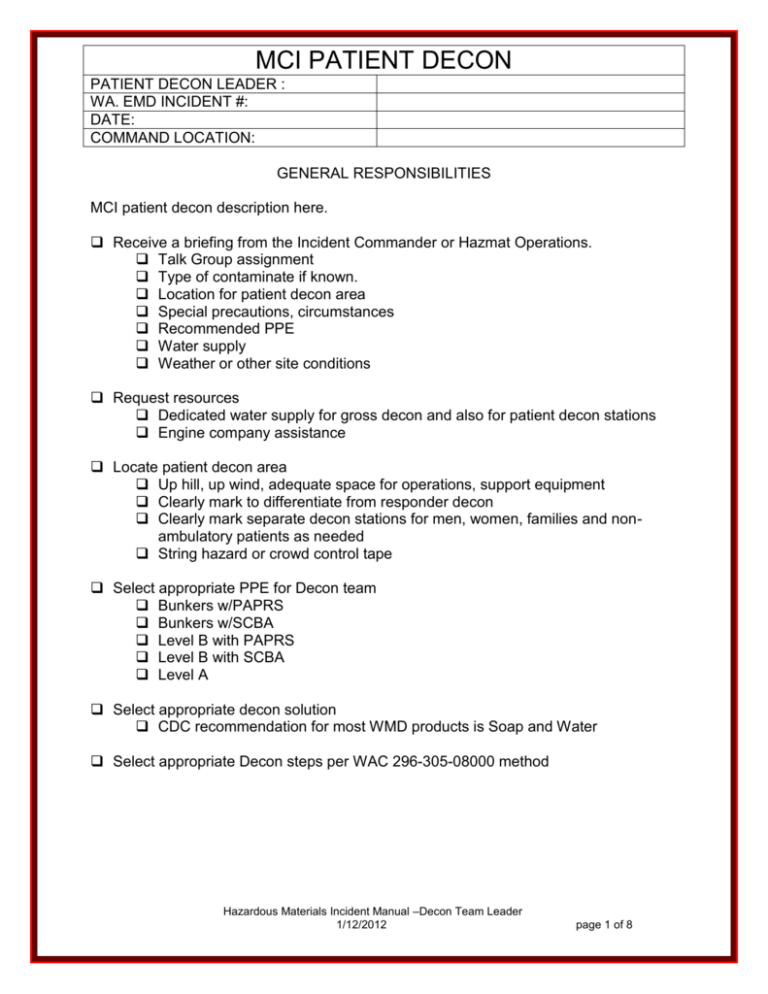
MCI PATIENT DECON PATIENT DECON LEADER : WA. EMD INCIDENT #: DATE: COMMAND LOCATION: GENERAL RESPONSIBILITIES MCI patient decon description here. Receive a briefing from the Incident Commander or Hazmat Operations. Talk Group assignment Type of contaminate if known. Location for patient decon area Special precautions, circumstances Recommended PPE Water supply Weather or other site conditions Request resources Dedicated water supply for gross decon and also for patient decon stations Engine company assistance Locate patient decon area Up hill, up wind, adequate space for operations, support equipment Clearly mark to differentiate from responder decon Clearly mark separate decon stations for men, women, families and nonambulatory patients as needed String hazard or crowd control tape Select appropriate PPE for Decon team Bunkers w/PAPRS Bunkers w/SCBA Level B with PAPRS Level B with SCBA Level A Select appropriate decon solution CDC recommendation for most WMD products is Soap and Water Select appropriate Decon steps per WAC 296-305-08000 method Hazardous Materials Incident Manual –Decon Team Leader 1/12/2012 page 1 of 8 Station #1 – Gross Decon: o Locate at edge of hot zone o Instruct patients to approach water spray o Decon ambulatory with low pressure water from engine o SCBA/bunkers minimum PPE for engine & hose operators o Do not contact contaminated patients without proper PPE o Instruct patients to move into warm zone o Rescue responders bring non-ambulatory patients through gross decon Station #2 - Clothing removal: o Responder PPE required for respiratory protection and skin contact o Distribute temporary coveralls or disposable blankets as needed for patients waiting o Attendant(s) assist/remove the outer clothing from patients. o Place clothing and personal items in an over-pack for later testing and further decontamination. Red Garbage cans Red Decon Bags Station #3 - Personal shower for ambulatory patients: o Responder PPE required for respiratory protection and skin contact o Attendants(s) instruct patients during washing o Patients wash and rinse entire body with mild soap and water. o Contain runoff water if possible, but secondary to removing contaminants from personnel. Soap solution in shower line Water line for rinse Station #4 - Drying off: o Patients dry off using towels or whatever is available. o Place items used in an appropriate container for disposal. Emergency clothing such as disposable coveralls. Disposable towels Station #5 – Shower for non-ambulatory patients o Responder PPE required for respiratory protection and skin contact o Remove outer clothing from patients o Place clothing and personal items in an over-pack for later testing and further decontamination. Red Garbage cans Red Decon Bags Hazardous Materials Incident Manual –Decon Team Leader 1/12/2012 page 2 of 8 o Remove contaminants as appropriate o Protect airway, observe vital signs o Dry, cover and move patient to gurney Station #6 - Medical evaluation: o Evaluate Patients by Medical o Check vital signs including temperature and level of consciousness. o Maintain medical evaluation and exposure forms. Station #7 - Transport to emergency room: o Medical transport patients exhibiting any signs or symptoms of exposure for further evaluation and observation. EXAMPLE LAYOUT MCI PATIENT DECON 1 HOT ZONE PPE: LEVEL A/B ENGINE WARM ZONE GROSS DECON PPE: SCBA 2 2 ENGINE ENGINE WOMEN DECON TEAM MEN 3 NON AMB 5 4 6 AID AID AID 7 WARM ZONE MASS DECON PPE: LEVEL B/C Hazardous Materials Incident Manual –Decon Team Leader 1/12/2012 COLD ZONE TRIAGE TREAT TRANSPORT page 3 of 8 MAP MCI PATIENT DECON Hazardous Materials Incident Manual –Decon Team Leader 1/12/2012 page 4 of 8 MCI RESPONDER DECONTAMINATION RESPONDER DECON LEADER : WA. EMD INCIDENT #: DATE: COMMAND LOCATION: GENERAL RESPONSIBILITIES The Port of Seattle Fire Department has the responsibility for Responder Decon when responding to a Mass Decon response with Zone 3 resources off of the Airport Property. The Port of Seattle Fire Department Haz Mat team responds to instances of Mass Decon with the designated Haz Mat vehicle (777) and the designated Decon trailer (Decon 777). These units respond with a minimum of 3 personnel comprised of the on duty Haz Mat team. Receive a briefing from the Incident Commander or Hazmat Operations. Talk Group assignment Type of contaminate if known. Location for responder decon area Special precautions, circumstances Recommended PPE Recommended Decon Solution Water supply Weather or other site conditions Request resources Dedicated water supply Engine company assistance Locate responder decon area Up hill, up wind, separate from patient/civilian decon Clearly mark to differentiate from patient/civilian decon Select appropriate PPE for Decon team Bunkers w/PAPRS Bunkers w/SCBA Level B with PAPRS Level B with SCBA Level A Select appropriate decon solution CDC recommendation for most WMD products is Soap and Water Select appropriate Decon steps per WAC 296-305-08000 method Hazardous Materials Incident Manual –Decon Team Leader 1/12/2012 page 5 of 8 Station #1 - Segregated equipment drop: o o o Deposit contaminated equipment that will be used again in the "Hot" zone, disposed of, or decontaminated at a later time or place. Red Garbage cans Red Decon Bags Station #2 - Wash/rinse: o o Wash Entry Team with appropriate decontamination solution and rinse with water by attendant(s) to remove gross contamination. Multiple wash/rinse steps depending on the severity of the hazards involved. Black Rectangular receptacles to stand in First wash Second wash Rinse Soap and water with brushes Station #3 - Outer protective clothing removal: o o o Attendant(s) remove the outer protective clothing from Entry Team. Use caution to avoid touching the inside of the suit while removing it. Place protective clothing that has been removed in an over pack for later testing and further decontamination. Red Garbage cans Red Decon Bags Station #4 - Removal of SCBA: o o Assist Entry Team removing their SCBA. Leave SCBA face piece in place and the low pressure hose held away from any potentially contaminated inner clothing. Station #5 - Removal of inner clothing: o Remove all clothing worn inside the suit in cases where the suit has been penetrated and the entry personnel are contaminated. Zumro Tent Clothes into Red Decon Bag Deposit Bags into Red Garbage Cans Station #6 - Personal shower: o o Entry Team washes and rinses entire body with mild soap and water. Contain runoff water if possible, but secondary to removing contaminants from personnel. Soap solution in shower line Water line for rinse Station #7 - Drying off: o o Entry Team dry off using towels or whatever is available. Place items used in an appropriate container for disposal. Emergency clothing such as disposable coveralls. Disposable towels and disposable Tyvec suits Station #8 - Medical evaluation: o o o Evaluate Entry Team by Medical Check vital signs including temperature and level of consciousness. Provide evaluation form to the team safety officer to be included in the member’s exposure records. Station #9 - Transport to emergency room: o Medical transport personnel exhibiting any signs or symptoms of exposure for further evaluation and observation. Hazardous Materials Incident Manual –Decon Team Leader 1/12/2012 page 6 of 8 USAMRIID’s Medical Management of Biological Casualties Handbook Dermal exposure to a suspected B/W aerosol should be immediately treated by soap and water decontamination. Careful washing with soap and water removes nearly all of the agent from the skin surface. Hypochlorite solution (bleach solution) or other disinfectants are reserved for gross contamination(i.e. following the spill of solid or liquid agent from a munition directly onto the skin). In the absence of chemical or gross biological contamination, these will confer no additional benefit, may be caustic, and may predispose to colonization and resistant superinfection by reducing the normal skin flora. Grossly contaminated skin surfaces should be washed with a 0.5% sodium hypochlorite solution, if available, with a contact time of 10 to 15 minutes. To mix a 0.5% sodium hypochlorite solution, take 1 part Clorox and 9 parts water (1:9) since standard stock Clorox is a 5.25% sodium hypochlorite solution. The solution is them applied with a cloth or swab. The solution should be made fresh daily with the pH in the alkaline range. Chlorine solution must NOT be used in (1) open body cavity wounds, as it may lead to the formation of adhesions, or (2) brain and spinal cord injuries. However, this solution may be instilled into non-cavity wounds and then removed by suction to an appropriate disposal container. Within about 5 minutes, this contaminated solution will be neutralized and nonhazardous. Subsequent irrigation with saline or other surgical solutions should be performed. Prevent the chlorine solution from being sprayed into the eyes, as corneal opacities may result. For decontamination of fabric clothing or equipment, a 5% hypochlorite solution should be used. For decontamination of equipment, a contact time of 30 minutes prior to normal cleaning is required. This is corrosive to most metals and injurious to most fabrics, so rinse thoroughly and oil metal surfaces after completion. Hazardous Materials Incident Manual –Decon Team Leader 1/12/2012 page 7 of 8 Use NIOSH Guide for PPE and Decon solution selection. ABRIN Biotoxin CYANOGEN CHLORIDE Systemic Agent HYDROGEN CYANIDE Systemic Agent LEWISITE Blister Agent SULFER MUSTARD Blister Agent POTASSIUM CYANIDE Systemic Agent RICIN Biotoxin SARIN Nerve Agent SODIUM CYANIDE Systemic Agent SOMAN Nerve Agent TABUN Nerve Agent VX Nerve Agent Radiological Information Casualty Management After Detonation of a Nuclear Weapon in an Urban Area Causality Management After a Deliberate Release of Radioactive Material Radioactive Contamination and Radiation Exposure. Distribute CDC Fact Sheets to Patients ABRIN ARSINE ANTHRAX BENZENE BOTULISM BROMINE CHLORINE CYANIDE HYDROGEN FLORIDE (HYDROFLUORIC ACID) LEWISITE NITROGEN MUSTARDS PARAQUAT PHOSGENE PHOSGENE OXIME PLAGUE RICIN RIOT CONTROL AGENTS SARIN SMALL POX SODIUM AZIDE SOMAN STRYCHNINE SULFUR MUSTARD TABUN TULAREMIA VIRAL HEMORRHAGIC FEVERS VX Hazardous Materials Incident Manual –Decon Team Leader 1/12/2012 page 8 of 8

